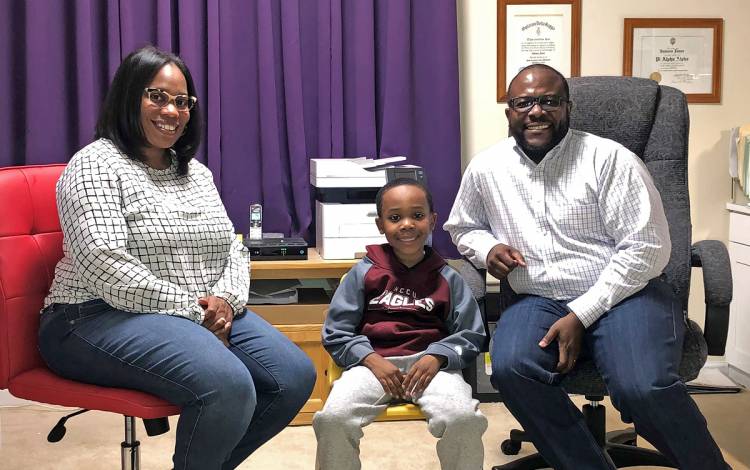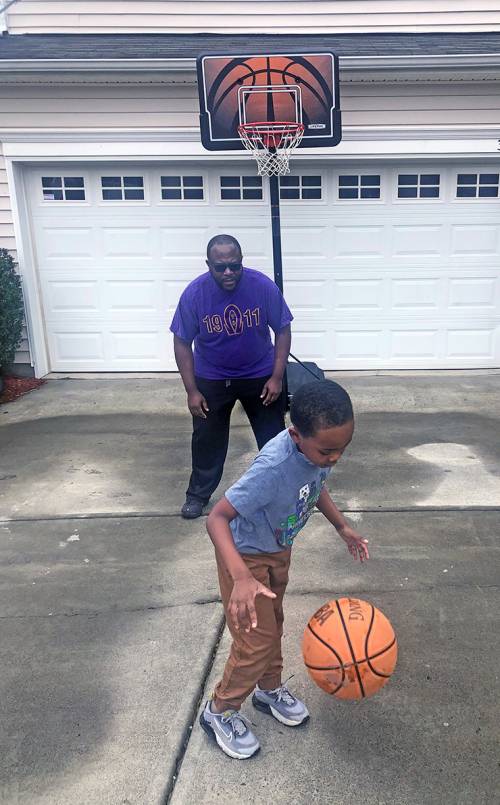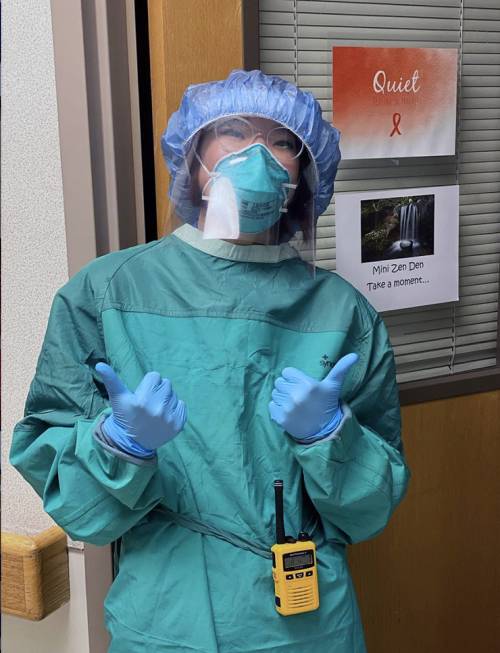One Year Later: Lessons from the Pandemic
A year after the onset of COVID-19, Duke colleagues share what they've learned


When Matt Sears was asked last August to help set up sites for Duke's COVID-19 surveillance testing program, he knew the task would be challenging but an essential part of returning to work and resuming in-person learning.
It took months to perfect the nationally noted program, which processes roughly 22,000 tests of students, faculty and staff each week. Meanwhile, the several dozen Duke employees who staff the 12 sites and one mobile unit – most redeployed from other areas of Duke – had to learn new roles and overcome nerves.
“We definitely felt a sense of purpose,” said Sears, Duke's director of surveillance testing operations. “We wanted to make a positive contribution to keeping classes running.”
In the year since quarantine due to the pandemic, Duke has found ways to keep moving forward as an institution, offering in-person and remote learning. While caring for patients, Duke University Health System has delivered more than 100,000 doses of the COVID-19 vaccine. And last week, news arrived that all on the Duke payroll, including teaching assistants and research assistants, will have an opportunity to schedule an appointment for a COVID-19 vaccination beginning March 17.
Behind the wins of the past year, there are individual stories of Duke staff and faculty who have learned valuable lessons about work and life during uncertain times. Here are some of their stories.

Robert Coffey
Executive Director of Duke Dining Services
During the early days of the pandemic, Robert Coffey and his team considered how Dining Services would feed guests, including where on campus and how employees could safely carry out their work together.
The staff met daily through the spring and summer of 2020 to prepare for the fall semester with about 2,900 students on campus, and during team brainstorming sessions, they learned to base decisions on a guiding principle to provide the best and safest dining experience.
To safely provide 8,000 daily meals on campus during the fall semester, Dining expanded mobile ordering options and outfitted eateries with designated entrances, exits and single-direction aisles. Employees and contractors completed training on sanitation and disinfecting practices, mask wearing, food packaging and guest interaction.
The fall semester began with socially distanced in-person dining at the Brodhead Center, Bryan Center and Marketplace. In October, in-person seating was removed based on safety guidance that identified eating with others as a common way to spread the virus. At points over the past year, Dining added an outdoor food cart, and for Black History Month this past February, team members expanded the menu to offer shrimp creole, jerk chicken and other dishes.
All dining service is currently pick-up only, and locations serve every meal in recyclable or compostable to-go containers with compostable utensils.
“Our lesson was acknowledging that it's OK to try new things, fail and try again, as long as it's with the purpose of providing safe and exceptional service,” Coffey said. “We have to stick to our core values.”

Debrah Suggs
IT Analyst, Duke Office of Information Technology (OIT)
Prior to the COVID-19 pandemic, Zoom was just one of digital tools offered by OIT that Debrah Suggs helped manage. Back then, the video conferencing tool had less than 4,000 registered Duke users and if any of them had trouble, or wanted to learn about cool features, they could email Suggs or attend one of her occasional workshops.
But last March, when Zoom became one way for Duke's remote workers to communicate and collaborate, Suggs role as Duke's resident Zoom expert took on new meaning.
“Zoom became a critical service overnight,” Suggs said.
Since the pandemic, Suggs and her colleagues have led around 40 webinars helping Duke employees learn how to use Zoom, while fielding a steady flow of questions from users. And since March of 2020, users have combined to average around 232,500 Zoom sessions per month.
Suggs called upon skills she honed many years ago when she taught first grade at Liberty Christian School. In that role, she learned that, aside from expertise, patience and empathy were essential parts to teaching someone something new.
“You have to be patient.” Suggs said. “Sometimes people just need you to take a moment and break things down in simple terms.”
Anna Rodrigues

Assistant Professor of Radiation Oncology
Anna Rodrigues learned to replace in-person teaching with her iPhone 8 and a handheld tripod.
Last fall, Rodrigues taught “Clinical Practicum and Shadowing (Radiation Therapy)” with Zhiheng Wang, professor of radiation oncology, over WebEx, a videoconferencing platform. The Medical Physics Graduate Program course covers how to operate cancer-treating devices such as MRI machines, CT scanners and linear accelerators, which produce radiation to treat tumors.
Rodrigues spent time in empty patient rooms at the Duke Cancer Center preparing for the course. She practiced teaching a class on her iPhone so she could move around patient rooms to show off parts machines used for treating cancer.
“My laptop camera wasn't going to cut it,” Rodrigues said. “These students needed to get close to the machines to see the fine details.”
Rodrigues attached her iPhone to a handheld tripod, so the camera remained steady as she showed the machines to students.
Ericka Chorniak, a second-year student in the Duke Medical Physics Graduate Program, took “Clinical Practicum and Shadowing (Radiation Therapy)” with Rodrigues. Chorniak said the virtual method helped her better understand the linear accelerator machine.
“Dr. Rodrigues created a dynamic class,” Chorniak said. “Seeing her interact with the machines in real-time gave me the confidence to handle them when it comes time for hands-on learning.”

Antonio Jones
Financial Management Analyst II, Duke Clinical Research Institute

Working from his Durham home five days a week, Antonio Jones has a nice workspace, complete with a printer, a built-in bookcase and a big monitor. His wife Demetria, who is working from home, and the couple's son, Aiden, whose first-grade classes are online, have workspaces a few feet away.
“We call this our achievement center,” Jones said of the converted loft they all share.
If there's a signature image for pandemic life in the Jones, the family's shared workspace is certainly one of them. But after noticing the blurring of lines between work and life, Jones is making sure remote work and his son's virtual school aren't the only memories the family takes from this time.
After noticing that he'd spend long days locked in on work early on in the pandemic, Jones has become more intentional about spending quality time with his family.
On weekends, the family makes it a point spend time together outdoors or watch movies while sharing popcorn. Jones also often takes a few minutes during the workday to help Aiden build Lego creations or shoot at the basketball goal in the family's driveway.
“I've become more conscious of spending time where it matters,” Jones said. “Time is a resource and you've got to utilize your resources where they're most important.”
Emily Jamieson

Clinical Nurse, Duke University Hospital
As an oncology nurse for Duke University Hospital, Emily Jamieson treats cancer patients who are undergoing chemotherapy and sometimes fighting COVID-19 simultaneously.
While days can be filled with death and declining health, Jamieson has learned to think of something she's grateful for each day during the pandemic.
“We see a lot of death and sadness in this job, and when the pandemic started, coworkers and I were nervous it would get worse,” Jamieson said. “I've always been a pretty upbeat person. I wanted to lean into that by intentionally expressing what I'm thankful for.”
Gratitude is a low-effort, high-yield benefit that reprograms your brain to focus on the positives, according to Bryan J. Sexton, director of the Duke Center for Healthcare Safety & Quality.
Since last March, Jamieson has used Instagram as a virtual journal for documenting her gratitude. She posts about cuddles on the couch with her golden retriever Mason and black Labrador Chloe; quick dance breaks with colleagues to Drake and Missy Elliot songs; and soothing a patient worried about infusion therapy.
“I'm learning to cling to the good in the world. The good moments get me through the bad,” Jamieson said. “You have to remember there are things in life worth fighting for.”
Help share the proactive and extensive work being done by all Duke community members during the COVID-19 outbreak. Send ideas, shout-outs and photographs through our story idea form or write working@duke.edu.